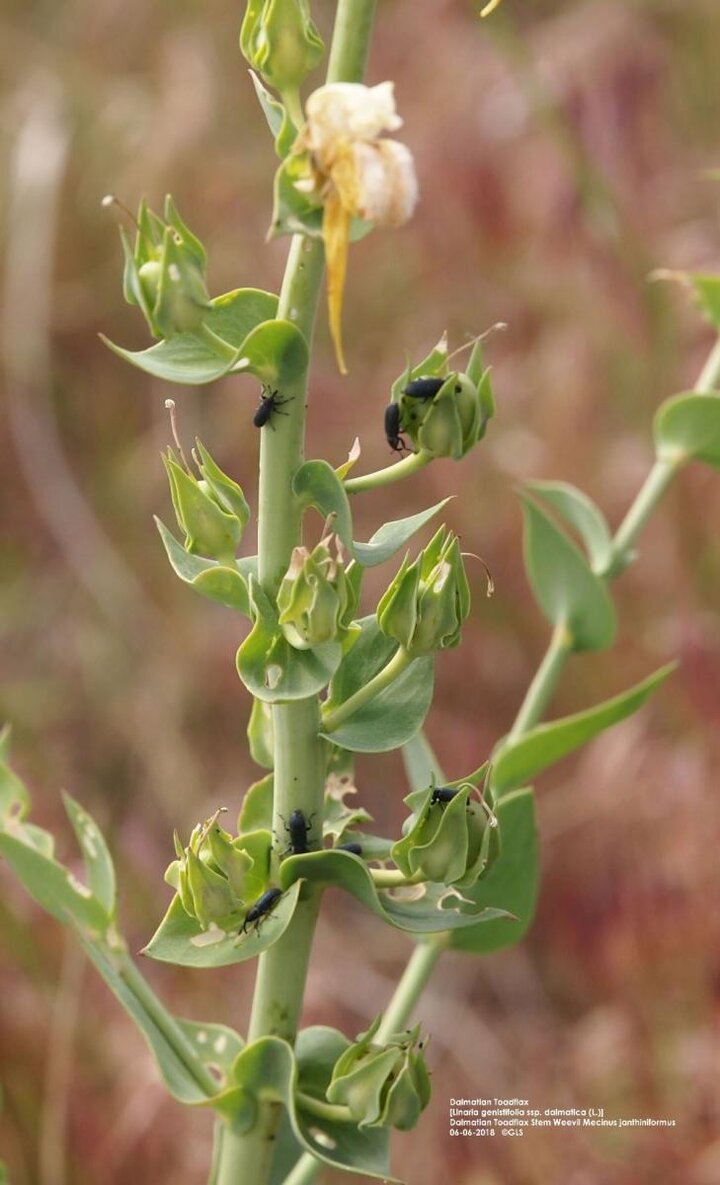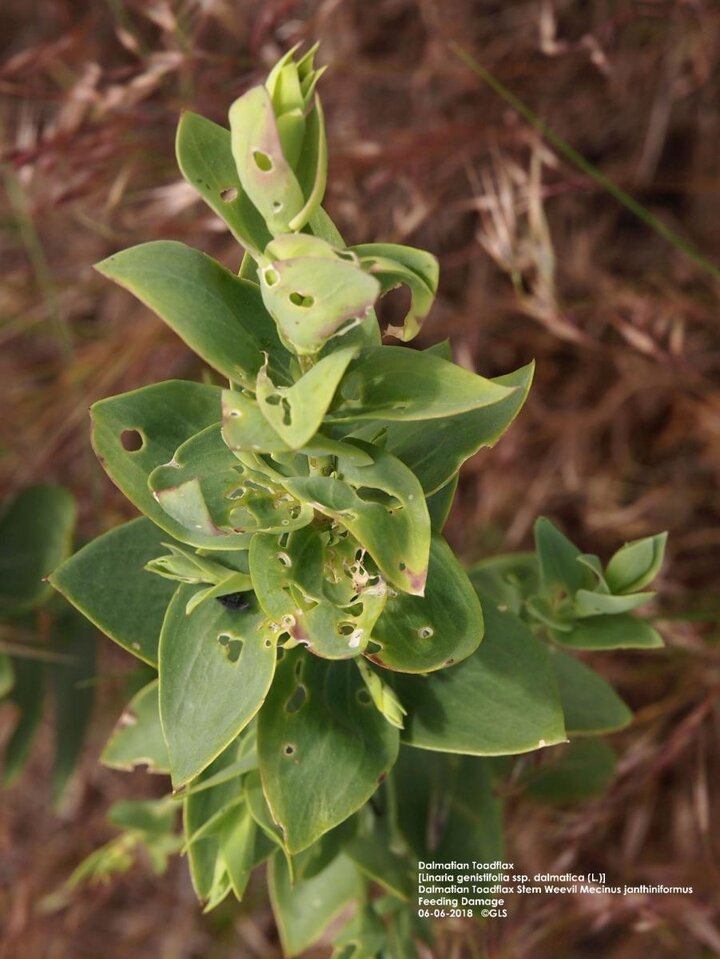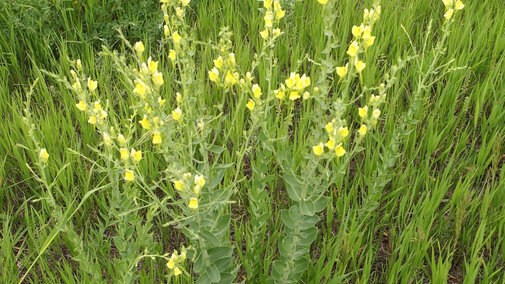
This is one in a series of articles on current or potential invasive species in Nebraska by the Nebraska Extension Invasive and Resistant Pest Issue Team.
Early Detection and Rapid Response (EDRR) is a concept to identify potential invasive species prior to or just as the invasive is becoming established. An Integrated Pest Management plan (IPM) can be developed to manage, contain, and eradicate the invasive species before it can spread further. This will avoid costly, long-term control efforts.
Dalmatian toadflax is a perennial herb identified in parts of Nebraska, mostly in Panhandle counties bordering Colorado, South Dakota, and Wyoming. Dalmatian toadflax is either a state or a local noxious weed in Colorado, South Dakota, Wyoming and other western states.
Dalmatian Toadflax
- Also known as: Broadleaf toadflax, wild snapdragon, flaxweed
- Scientific name: Linaria genistifolia ssp. dalmatica (L.)
- Family: Scrophulariacea (Figwort family)
- Origin: Eurasia and Mediterranean area
Description
First reported in North America in the mid-1800s, it was brought to the U.S. as an ornamental and used for folk remedies and to make yellow dye. Now dalmatian toadflax is distributed across most of Canada and the United States, except the southeast.
Dalmatian toadflax is an herbaceous short-lived perennial herb. A prolific seed producer, it reproduces/spreads by seed and underground root stocks. Large mature plants can produce up to 500,000 seeds per year. Seeds do not require a dormancy period before germinating and can remain viable in the soil up to ten years. Some seeds can germinate in the fall of the year, but most germinate in April or May of the following spring. Seed is spread by wildlife, vehicles, construction equipment, livestock, forages, feed grains, soil and gravel.
Dalmatian toadflax has an extensive root system. Lateral roots spread out 10 feet from the base of the plant and can extend down 4-10 feet.
It can grow to 2 to 3 feet tall. Leaves are generally broad, spade-shaped with smooth margins. The bases of the leaves wrap around the shoot. The leaves are waxy, which reduces the ability of herbicides to move into the plant.
Dalmation toadflax flowers are in the axils of the leaves in a spike at the end of each stalk. Flowers are yellow to orange in color and produce a two-cell fruit capsule, which contain the seeds.
Habitat
Dalmatian toadflax is adaptive to a wide range of environmental conditions. This plant favors disturbed sites and is found in rangeland, pastures, waste areas and roadsides. Dalmatian toadflax is very aggressive and competes with native vegetation for soil nutrients and water. This plant will dominate the affected site in time, leading to an eventual monoculture.
It has no forage value for livestock and contains a poisonous glucoside that is harmful to livestock. It is not harmful to sheep or goats.


Management
Prevention is the best and cheapest management option. Detect infestations early and keep them from spreading. Having well-established grasses and forbs on a maintained pasture or rangeland with proper grazing and rotational grazing techniques can go a long way to prevent its establishment. Scouting, proper identification, and monitoring are key to management as infestations and spread of this weed can occur rapidly.
Mechanical Control. Pulling or cultivating small Dalmatian toadflax plants can be an effective control method, as long as the plants are young and haven’t gone to seed. The entire lateral roots need to be removed and an herbicide treatment may be necessary. Mowing alone will not control Dalmatian toadflax. Timely mowing can reduce the amount of seed produced.
Biological Control. Grazing Dalmatian toadflax seedlings with sheep can help prevent establishment; however, grazing mature plants will not kill the plants and may stimulate new growth from the roots.
Several insects can have an effect on Dalmatian toadflax. The beetle, Brachypterolus pulicarius, feeds on the ovary. Mecinus janthiniformus (Figures 3-4) is a stem-boring weevil that suppresses flower and seed production. Two other weevils, Gymnaetron antirrhini and Gymnaetron netum, feed on the seed capsule. Another moth, Calophasia lunula, defoliates up to 20% of the leaves on a single plant. These biological controls may reduce the infestation of Dalmatian toadflax, but they will not control it. Other methods must be used in combination to reduce and control the infestation.
Chemical Control. A few chemical treatment options, such as products containing chlorsulfuron, dicamba, imazapic or picloram, can be used to control Dalmatian toadflax.
Consult the specific herbicide label for rates, application timing and other instructions for treating Dalmatian toadflax. The waxy leaves and stems affect herbicide coverage and uptake and cause erratic control. It is important to follow the product label unique to each herbicide. When the herbicide label allows, the use of a crop oil concentrate (COC), methylated seed oil (MSO), or other oil-based adjuvant may improve herbicide penetration through the waxy leaf cuticle. Retreatment of infested areas with Dalmatian toadflax may be needed due to the long life of the seeds.
Be sure to select a product labeled for the site. Read, understand and follow all label instructions when using any pesticide. Create an Integrated Pest Management plan (IPM) combining different control strategies to manage Dalmatian toadflax and promote the desired plant community you want.
References
Beck, K.G., Biology and Management of the Toadflaxes, Colorado State University, Fact Sheet Number 3.114
Goodwin, K. and Burch, D., Watch Out for Toadflax, Montana State University Extension, EB0181
Kadrmas, T. and Johnson, W.S., Managing Yellow and Dalmatian Toadflax, University of Nevada, Fact Sheet FS-02-96
Ogden, J.A. and Renz, M.J., Dalmatian Toadflax (Linaria genistifolia ssp. Dalmatica), New Mexico State University Weed-Factsheet
USDA/NRCS Plant Profile, Dalmatian Toadflax, Linaria dalmatica L.

